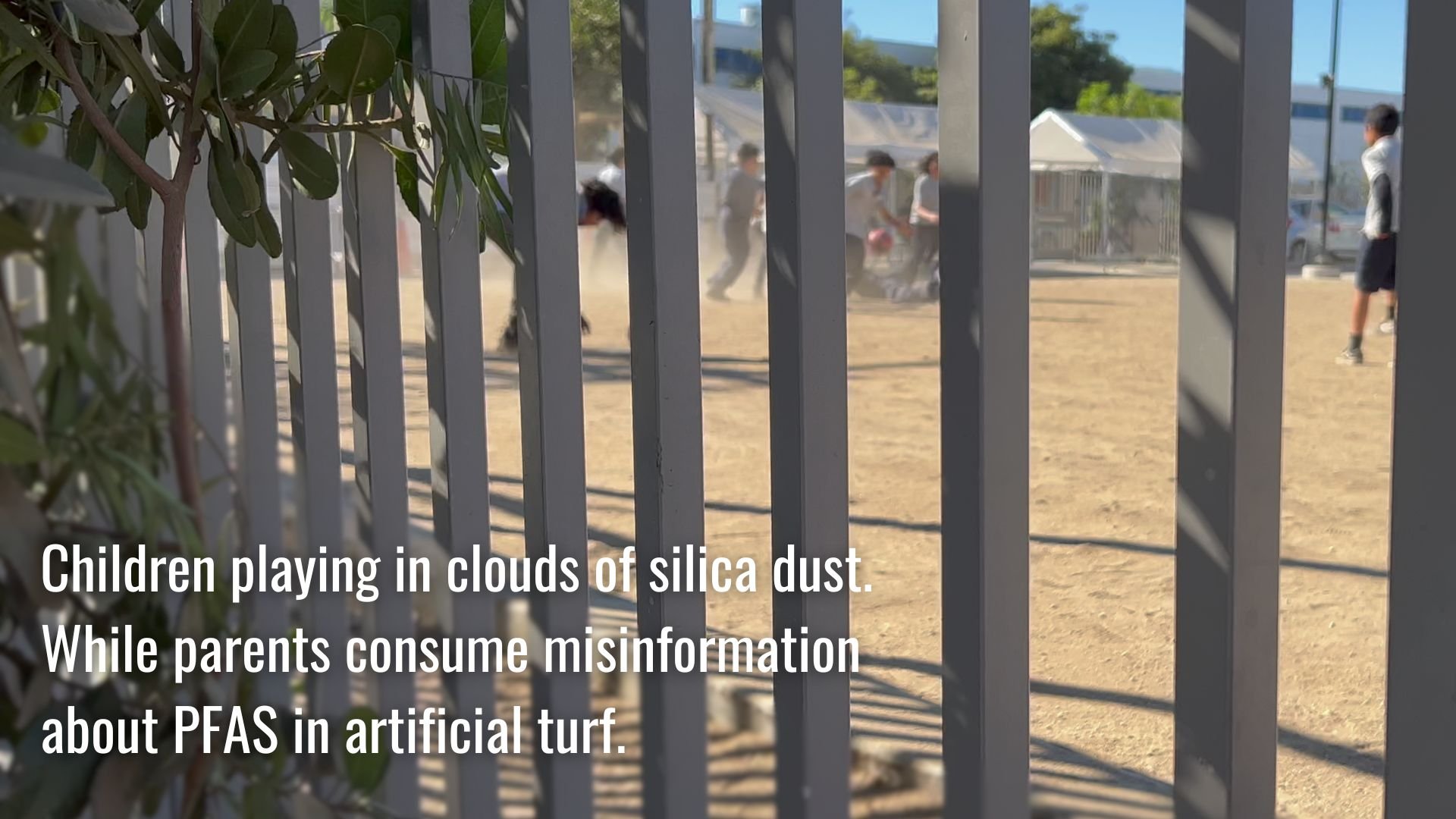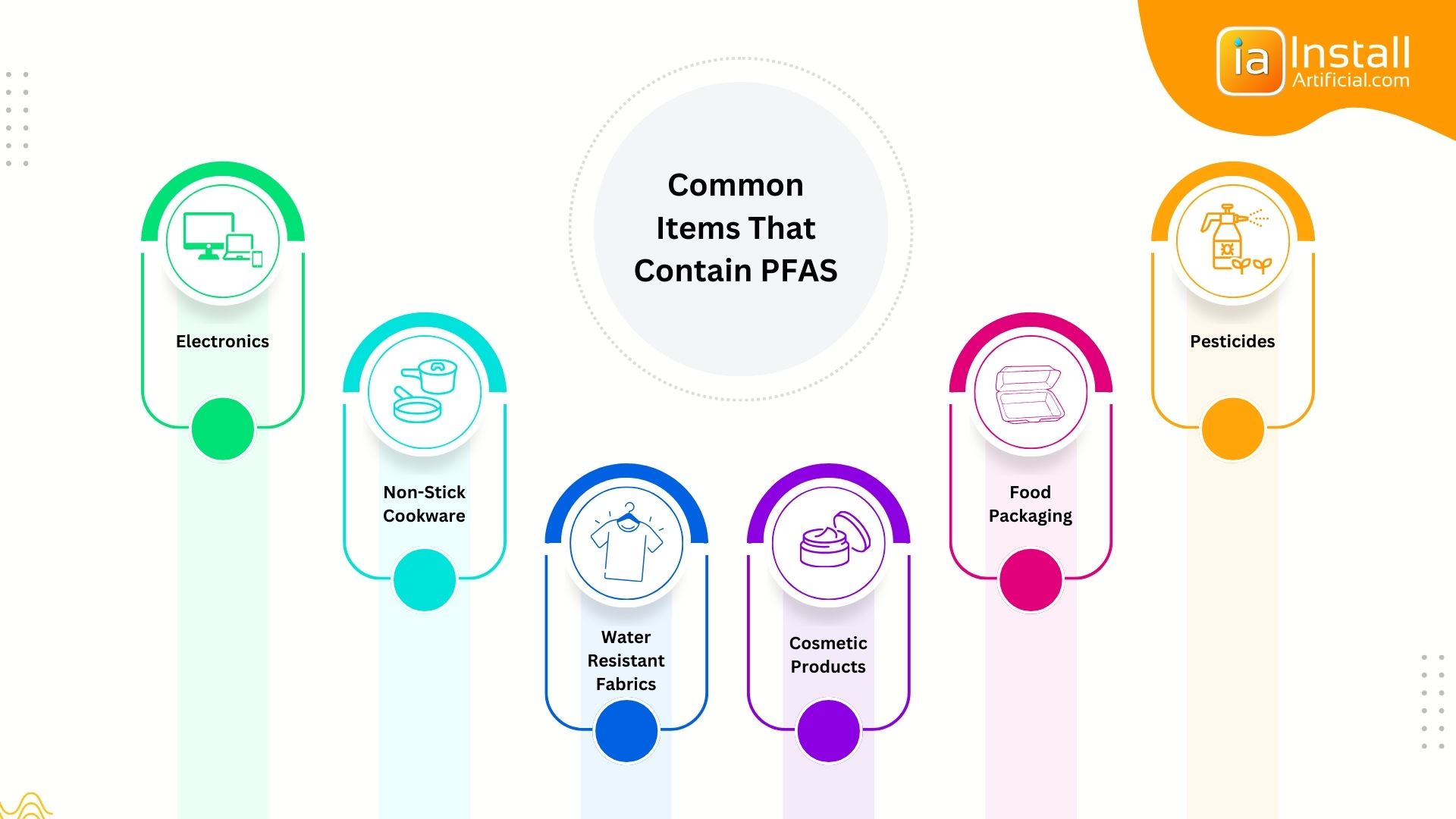
Learn the benefits of opting for artificial grass installation in Los Angeles residential neighborhoods and other spaces. Hear why more and more homeowners are making...
Artificial turf has been a subject of controversy in California with Gov. Newsom's new legislation allowing cities to ban artificial grass. However, it is essential to challenge these claims and examine the evidence before making hasty decisions. 
From the Authors:
As a result of statement that PFAS in artificial turf is toxic for children and athletes, more and more people are considering decomposed granite and pesticide-treated turf additives as preferable alternatives for their playgrounds.
More often, we see children playing in clouds of concentrated silica dust, dragging pesticides into homes and schools, or simply staying indoors with gadgets in their hands.
In crafting this article, our aim is to provide insightful analysis of information concerning PFAS in artificial turf. Throughout the text, you will encounter numerous links containing valuable data. Should you come across any statements needing clarification or correction, we welcome your comments.
As a parent of two young children, my priority is to ensure the safety and well-being of not only my own kids but also their friends.
In light of CalMatters' recent article highlighting the concerns raised by clients regarding the safety of artificial turf we are witnessing a decline in turf installations. This leads to an increase in water consumption, a rise in dust inhalation, and a decrease in vegetable consumption, hurting our children and most vulnerable families during unprecedented inflation. However, the impact of PFAS and the effectiveness of recycling efforts remain minimal or unknown. These developments are cause for concern, and it is imperative that we find solutions to address these issues. Let's work together to correct the course for the benefit of all.
When it comes to the debate surrounding the safety of artificial grass, there is a constant exchange of opinions. Let's start by expressing our shared concern for people's well-being. We don't want anyone inhaling potentially harmful chemicals or putting their families in danger. However, let's dive into the details and carefully analyze the information and evidence presented:
Many articles make claims about the presence of PFAS chemicals in artificial grass without providing any evidence or data to support this. It is important for media organizations to provide accurate and reliable information to avoid misleading the public and perpetuating false narratives. We analyzed CalMatters article on Nov 9th, 2023 as a vivid example. However, this is true to many other articles about PFAS in artificial turf that readers can find online.
The CalMatters article implies that all artificial grass applications feature crumb rubber, which could be misleading the public because this is an old technology that has been filtered out of current day residential applications. In fact, in about 7 years of installing artificial turf, we had to deal with rubber infill only once, when requested by a client. The reality is, even for sports fields, there are numerous organic infill alternatives that are considered safe and provide similar performance. Natural items such as cork and walnut shell have become more mainstream within the industry.
The articles focuse mainly on the presence of PFAS in crumb rubber, but fail to mention that this is a rare infill option used these days, specifically almost never used in residential application. You can't test a 15 year old sports field covered in crumb rubber and conclude that all current day artificial grass applications are unsafe.
In a Technical Memorandum by Sandra Goodrow, Ph.D., Research Scientist, we learn that most definitive links to PFAS through testing turf samples is stemming from the crumb rubber infill. In a 2022 Research Study at Stockholm University, researchers tested 51 samples of artificial turf and with detectable amounts of PFAS showing in 42% of the samples. However, tests using extraction with water only did not show detectable levels in the water. And there was no detection of PFAS in the blades.
Sandra goes on to state "While the Stockholm study compiled a larger representative sample, it is unclear if this sample is representative of the types of artificial turf available in the United States. If the samples are representative of artificial turf placed in the U.S., the study appears to suggest that low levels of PFAS may be released from the product and the larger portion of PFAS detected is within the structure of the material. However, the lack of analytical methods that identify and quantify all potential PFAS limits the ability to make absolute conclusions."
This raises the question: what type of artificial grass products are they using for these studies? Are they using high quality American made artificial grass or shipping low grade turf from overseas? Rather than definitively condemning a product that has major benefits, why not regulate the manufacturing and import process to ensure all materials are safe?
In the article discussing the ability for cities to ban artificial grass, CalMatters overgeneralized by emphasizing only a few drawbacks of artificial grass without fully acknowledging its potential benefits or technological advancements. For instance, they have highlighted concerns about the environmental impact of artificial turf without considering newer eco-friendly options and have failed to address improvements in its composition and recyclability.
Additionally, articles fail to address opposing viewpoints or provide a balanced perspective. It presented a one-sided narrative that painted a negative picture of artificial grass without considering its potential benefits or the reasons behind the ban. This omission of essential information further contributed to the misleading nature of the article. A thorough examination of the claims and evidence presented reveals the flaws in the article's argumentation and highlights the need for more rigorous research in journalism.
There has been evidence of PFAS in certain consumer products such as plastic rubber which is the biggest link to artificial grass. This same rubber is in items we use every day. The claim that all artificial grass contains PFAS is not backed. Most commercial and residential applications no longer use crumb rubber infill or backing.
Misleading information in the media can have far-reaching consequences. In a world where news and information are easily accessible, it is crucial for journalists and media organizations to provide accurate and reliable content. When misleading information is given, it can misinform the public, shape public opinion, and even influence decision-making processes.
One of the key issues with misleading information is that it can perpetuate false narratives and beliefs. This can lead to the spread of misinformation, which can have serious consequences, especially in areas such as public health. Upon closer examination, it became evident that the CalMatters article lacked proper research and relied on anecdotal evidence rather than empirical data.
In an excerpt from their article, they mention a conversation they have with Adam Smith, an associate professor of environmental engineering at the University of Southern California. He admits that while that while PFAS is bad for human health, research is still being done to fully understand the health implications of the chemical.
When considering the health risks, it's important to note that PFAS can be found in several items that you and your children come in contact with every day.
Singling out artificial turf as a primary source of PFAS exposure overlooks a more complex landscape of potential sources and solutions.
While discussions around banning artificial turf might appear well-intentioned, they fail to address the broader spectrum of materials containing PFAS. It's crucial to recognize that PFAS compounds are not solely exclusive to synthetic grass, and we have yet to see any definitive evidence that PFAS is even present in high quality artificial grass. PFAS is found in various everyday items, including rubber used in tires, asphalt, and materials commonly used in children's playgrounds.
Rubber, a material deeply embedded in our daily lives, is prevalent in numerous forms, notably in tires and playground surfaces. Tire wear on roads and highways results in the dispersion of micro-plastics and rubber particles containing PFAS into the environment. The same applies to playgrounds surfaced with rubber, potentially contributing to PFAS exposure among children.
Focusing solely on banning artificial turf ignores that PFAS is used in multiple products and environments. Rather than fixating on one aspect, a more effective approach involves comprehensive scrutiny and regulation of all materials containing these harmful substances.
According to the Environmental Protection Agency, PFAS chemicals, known for their carcinogenic properties and disruptive effects on hormones, reproduction, and immunity, pose a significant threat to our environment and overall health. These harmful substances can be found in various sources such as water, soil, air, and even in the materials commonly found in our homes and workplaces.

Considering that these chemicals can be found in common household items, it raises the question: Why is artificial turf being singled out as worse than these other everyday products that contain PFAS? This becomes especially interesting when you also remember that one claim isn't even that PFAS is present artificial turf itself, but in crumb rubber which is no longer a commonly used infill.
As communities across Southern California grapple with concerns over water scarcity in the aftermath of a decade-long drought, the idea of condemning artificial turf due to potential PFAS chemicals appears to be a shortsighted and populist approach by certain segments of the government and media. This proposal by the governor that's backed by CalMatters, while aiming to address environmental worries, overlooks the complexity of the issues at hand.
The recent drought has left deep scars on the availability of water resources in numerous regions, highlighting the urgency of sustainable water management. Artificial turf has often been championed as an alternative to natural grass lawns in the context of water conservation. Its minimal water requirements were seen as a viable option in times of drought, providing a solution for maintaining green spaces without excessive water consumption.
However, the proposal to ban artificial grass on grounds of potential PFAS exposure sends a conflicting message. While environmental concerns regarding PFAS are legitimate, the timing and context of such a ban raise questions about its effectiveness and the priorities at play.
Instead of hastily imposing bans on artificial grass, efforts should be focused on comprehensive measures that address both PFAS concerns and water conservation. This could involve regulations on the manufacturing and disposal of turf materials, combined with investment in sustainable water management practices.
Education and awareness programs can empower communities to make informed choices about their environmental impact. Encouraging responsible installation and maintenance practices for artificial turf can lower potential risks associated with PFAS while continuing to support water-saving initiatives.
The proposed ban on artificial turf, aimed at addressing concerns over PFAS chemicals, could unintentionally worsen the challenges surrounding water consumption and agricultural costs, particularly in the production of fruits and vegetables. This shift has the potential to significantly impact the affordability and accessibility of nutritious food, especially for children.
Artificial turf has been praised as a water-saving alternative to traditional grass lawns, especially during periods of drought. Its lower water requirements make it an appealing choice for homeowners looking to reduce their water usage. However, banning artificial turf may result in increased water usage for landscaping purposes, as maintaining natural grass demands considerably more water, especially in dry regions that are already dealing with water scarcity.
The consequences of heightened water usage extend beyond residential areas. The agricultural sector is heavily reliant on water resources and could be greatly affected. With water scarcity already straining farming operations, an increase in water demand due to natural grass could significantly drive up production costs.
The rising cost of farming directly impacts the affordability of fruits and vegetables, which can have significant consequences for consumers, especially children. If agricultural production expenses increase due to higher water usage for maintaining natural grass, it could result in elevated prices for produce.
"The standard model currently used to forecast the global availability of water projects that increasing water scarcity and other factors will slow agricultural growth and raise food prices in the coming years." - US Bureau of Labor Statistics
These essential foods are vital for a balanced diet and contribute to children's growth and development. An increase in agricultural costs, leading to inflated prices, may restrict your ability to purchase these important food items.
When evaluating what is healthier, it becomes evident that various factors come into play. Artificial turf, despite "potential" concerns related to PFAS, contributes to water conservation, indirectly supporting sustainable agriculture. The affordability and accessibility of fruits and vegetables, which are crucial for children's health, are closely linked to the cost of farming, which is influenced by water availability and consumption.
Is it equitable to allow the banning of artificial grass in certain cities and not others? Why do certain affluent cities choose to use excessive amounts of water for lawn care, depriving farmers of much-needed resources, while other cities restrict the serving of drinking water in restaurants? Is this a matter of privilege?
Contrary to a common misconception, artificial grass installers are not trying to pressure homeowners into converting to synthetic grass. We understand the appeal of a lush, green natural lawn and know that there's nothing that can top this. The reality is, maintaining a natural lawn can be difficult, time-consuming, and expensive. That's why we recommend artificial grass for those with dirty, muddy, or bare lawns. By switching to artificial grass, you can transform your unusable and unsafe backyard space into a clean and enjoyable area for play and entertaining. If your current natural lawn is plush and soft for your family to play on, consider yourself lucky!

We only suggest switching to artificial grass when your natural lawn is struggling to survive or flourish. It's important to consider the potential risks of inhaling contaminants by leaving your lawn bare, as it's not safe for children to play in dirt and dust.
Contrary to popular misconceptions, a thorough comparison between artificial grass and natural turf reveals that artificial turf often contains fewer harmful chemicals, especially when it comes to pesticides and growth accelerators.
Maintaining natural turf often requires the use of pesticides, herbicides, and fertilizers to stimulate growth, control pests, and maintain its vibrant appearance. While these chemicals help with grass growth and pest management, they also present potential risks to the environment and human health. Pesticides, in particular, have raised concerns due to their associated health hazards and environmental impact.
On the other hand, artificial grass offers the advantage of not requiring the regular application of pesticides or growth accelerators. Once it is installed, there is no need for the chemical treatments commonly used in the maintenance of natural turf. This not only eliminates ongoing chemical usage but also significantly reduces the potential environmental and health risks associated with pesticide exposure.
According to the Environmental Protection Agency, "Lawn chemicals can be absorbed through the skin, swallowed or inhaled. During application, lawn chemicals can drift and settle on ponds, laundry, toys, pools and furniture. Even pets are at risk — studies by the Humane Society of the United States show that the rates of lymphoma in pets of pesticide users are significantly higher than occurrences in the pets of non-chemical users. Several types of cancer, immuno-response deficiencies, neurological diseases, and birth defects have been associated with exposure to lawn chemicals. By releasing chemical toxins into the environment, air and water quality suffer, ultimately causing health problems."
Modern day artificial turf installers often utilize materials and infill options that undergo thorough testing and certification for safety. Many manufacturers have taken the initiative to develop infill materials that are completely free from harmful substances, including PFAS. This ensures a safer environment for users without any compromise on performance or aesthetics.
While concerns about potential chemicals used in the production of artificial turf, such as PFAS, are valid and should be addressed through stricter regulations and safer alternatives, the comparison to the routine application of pesticides and growth enhancers in natural turf maintenance highlights the relatively lower chemical usage in artificial turf.
In conclusion, when considering the effects of chemicals like pesticides and growth accelerators, artificial grass proves to be a promising and safer alternative due to its minimal dependence on such substances.
Often we see homeowners making the switch to artificial grass because their lawns are barren and just dirt. When considering different landscaping options for lawns, such as keeping the dirt or applying decomposed granite, it is crucial to take into account the potential health implications, particularly for children and pets. Dust from deteriorating lawns or decomposed granite can pose health risks through inhalation, making artificial turf a safer choice.
When surfaces like decomposed granite are disturbed, tiny particles of dust can become airborne, especially in dry and windy conditions. This can lead to an increased risk of exposure to particles, which can irritate the respiratory system and worsen existing conditions such as asthma or allergies. Children and pets, who are more vulnerable to these health concerns, are particularly at risk.

The composition of decomposed granite and its tendency to generate fine particles raises concerns about the presence of silica dust. Silica dust is a component found in many natural minerals, including granite, and prolonged inhalation of this dust can pose serious health risks. Respiratory issues and conditions like silicosis, a potentially debilitating lung disease, can develop with prolonged exposure to silica dust.
According to the American Geophysical Union, "Human exposure to soil dust has been associated with adverse health effects, including asthma, fungal infections, and premature death"
Contrastingly, artificial turf provides a surface that is stable and does not produce dust particles. Its construction involves materials designed to prevent the generation of airborne particles, offering a low-dust environment suitable for children and pets to play on without the risk of inhaling harmful particles.
While artificial turf might raise concerns regarding certain materials used in its construction, such as infill options or backing materials, proper installation and choice of certified, safe materials can mitigate potential risks associated with these components. Artificial turf presents a low-dust environment, potentially offering a safer and healthier surface for children and pets to play on, reducing the risks of respiratory issues associated with dust inhalation.
With growing concerns about the safety and environmental impact of artificial turf, discussions surrounding its usage have sparked debates and calls for bans in various communities. However, exploring alternatives to an outright ban opens avenues for solutions that balance concerns for health, sustainability, and functionality.
Proposing an artificial turf certification system rather than an outright ban on artificial turf presents a more practical approach to address concerns about safety and environmental impact. Certification could serve as a means to regulate the quality and safety standards of artificial turf products available in the market, ensuring that only lead-free and safe options are accessible to consumers.
By establishing a certification process specifically designed to authenticate artificial turf products that are shipped in from overseas, we could set criteria regarding safety measures, including the absence of harmful substances or chemicals. Such a requirement would serve as a reliable indicator for consumers seeking safe and environmentally friendly turf options for their homes, sports fields, or public spaces. It would offer assurance that the purchased turf meets established safety standards, mitigating health risks associated with hazardous materials.
Implementing a certification system also promotes transparency within the industry. Manufacturers would be incentivized to comply with these safety standards to attain certification, encouraging the production and sale of higher-quality, safer artificial turf. Additionally, this approach allows for ongoing assessment and improvement of safety protocols, fostering innovation and advancement in turf manufacturing techniques.
Additionally, this system doesn't hinder the use of artificial turf but rather encourages responsible consumption by guiding consumers toward safer choices. It strikes a balance between allowing the use of artificial turf for its convenience and functionality while addressing legitimate safety concerns. This approach acknowledges that not all artificial turf poses the same risks and focuses on regulating and eliminating unsafe products from the market, benefiting both consumers and the environment.
Proposing a recycling fee on all turf sales as an alternative to banning artificial turf offers a sustainable approach to address environmental concerns while supporting the recycling infrastructure. Similar to the model implemented for tires, this initiative would involve levying a recycling fee on the purchase of artificial turf, creating a dedicated fund specifically for the development and maintenance of turf recycling facilities in major cities.
By introducing a recycling tax, consumers and manufacturers would share the responsibility of ensuring the proper disposal and recycling of artificial turf materials. This fee would contribute to financing the establishment and operation of specialized recycling centers equipped with the technology and expertise to efficiently process discarded turf. These facilities would aim to reclaim valuable materials from used turf, diverting them from landfills and minimizing the environmental impact associated with disposal.
The success of this approach lies in its ability to create a sustainable economy for artificial turf. Instead of banning turf outright, we demand responsible disposal practices and encourage the industry to adopt more environmentally friendly materials and manufacturing techniques. Moreover, by funding recycling in major cities, this initiative not only addresses the disposal issue but also creates jobs and promotes innovation in recycling technologies.
This proactive approach acknowledges the benefits of turf while reducing its environmental impact through responsible waste management and resource recovery.
Media organizations have a responsibility to uphold journalistic standards and provide accurate and reliable information. Fact-checking and thorough research are essential in ensuring that misleading information does not infiltrate the media landscape. By promoting media literacy and fact-checking, we can create a more informed society and prevent the spread of misinformation.

Learn the benefits of opting for artificial grass installation in Los Angeles residential neighborhoods and other spaces. Hear why more and more homeowners are making...